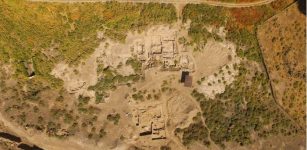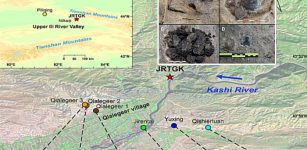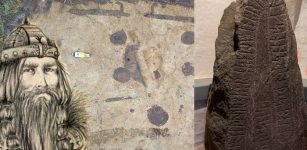Men And Women Had Equal Access To Resources 6,000 Years Ago
Conny Waters - AncientPages.com - An isotopic analysis conducted on ancient human remains indicates that men and women possessed equivalent access to resources approximately 6,000 years ago.
In orange, the location of the site of Barmaz, looking south. It is located on the plain, at the foot of the Chablais massif, which rises to an altitude of 2500 m. The site is divided into two contemporary burial areas named Barmaz I (dark blue) and Barmaz II (light blue) (Honegger and Desideri 2003, modified). Credit: Journal of Archaeological Science: Reports (2024). DOI: 10.1016/j.jasrep.2024.104585
Using isotope geochemistry, a team from the University of Geneva (UNIGE) has uncovered new information about the Barmaz necropolis in Valais (Switzerland): 14% of the people buried 6,000 years ago at this site were not locals.
This finding challenges the prevailing notion of gender-based disparities in resource allocation during that era and suggests a more egalitarian societal structure existed among the population under investigation.
This Middle Neolithic agropastoral society, recognized as one of the earliest known in the western region of Switzerland, exhibited a relatively egalitarian structure, a study says. The examined bones reveal that all members of the community, including people from elsewhere, had access to the same food resources.
The Neolithic era began with animal husbandry and agricultural practices. In Switzerland, this epoch spanned between 5500 BC and persisted until approximately 2200 BC. The first agropastoral communities gradually moved from a predatory economy—in which hunting and gathering provided the nutrients essential for survival—to a production economy.
The concentrations of specific isotopes of carbon, nitrogen, sulfur, and strontium are contingent upon the environmental context in which an individual lives and eats. The technique is being employed for the inaugural instance with alpine agropastoral populations originating from the Middle Neolithic era in the western region of Switzerland.
The Barmaz site at Collombey-Muraz in the Chablais region of Valais, Switzerland, is a significant archaeological discovery that sheds light on ancient agropastoral societies in the western part of the country. Excavations conducted in the 1950s and 1990s revealed two necropolises containing the skeletal remains of approximately seventy individuals. These human remains, among the oldest found in the region, provide valuable insights into the lives and practices of these early agricultural and pastoral communities.
The Barmaz site is an important source for studying the evolution of human settlements in this part of Switzerland.
For her master's thesis, Déborah Rosselet-Christ, the study’s primary author, meticulously selected 49 individuals, comprising an equal number of females and males. From these subjects, she methodically obtained collagen samples from specific bones, as well as enamel fragments from their second molars, in a systematic manner.
"The second molar is a tooth whose crown forms between the ages of three and eight," explains the researcher.
"Once formed, tooth enamel is not renewed for the rest of its life. Its chemical composition therefore reflects the environment in which its owner lived during childhood. Strontium (Sr) is a good marker of mobility. The ratio of abundance between two of its isotopes—i.e. their proportion—varies greatly depending on the age of the surrounding rocks. These chemical elements end up in the enamel via the food chain, leaving an indelible signature that is specific to each environment."
Analysis of the strontium isotope ratios in the 49 individuals from Barmaz reveals a high degree of homogeneity in most of them and markedly different values in only 14% of the samples, indicating a different origin.
"The technique makes it possible to determine that these are individuals who did not live the first years of their lives in the place where they were buried, but it is more difficult to determine where they come from," says Jocelyne Desideri, senior lecturer at the Laboratory of Archaeology of Africa and Anthropology in the UNIGE Faculty of Science, last author of the article.
"Our results show that people were on the move at that time. This comes as no surprise, as several studies have highlighted the same phenomenon in other places and at other times during the Neolithic period."
Written by Conny Waters - AncientPages.com Staff Writer
More From Ancient Pages
-
 Spells, Charms, Erotic Dolls: Love Magic In The Ancient Mediterranean
Featured Stories | Oct 24, 2022
Spells, Charms, Erotic Dolls: Love Magic In The Ancient Mediterranean
Featured Stories | Oct 24, 2022 -
 Ancient Mystery Of The Before – Time People – Evidence Of Unknown Advanced Prehistoric Technology – Part 2
Ancient Mysteries | Apr 5, 2019
Ancient Mystery Of The Before – Time People – Evidence Of Unknown Advanced Prehistoric Technology – Part 2
Ancient Mysteries | Apr 5, 2019 -
 Kap Dwa – Mysterious Two-Headed Mummified Patagonian Giant – Real Or Fake?
Featured Stories | May 20, 2021
Kap Dwa – Mysterious Two-Headed Mummified Patagonian Giant – Real Or Fake?
Featured Stories | May 20, 2021 -
 Can You Help Identifying This Strange Bamboo Cart Found In A Melted Glacial Path In Switzerland?
Archaeology | Nov 6, 2024
Can You Help Identifying This Strange Bamboo Cart Found In A Melted Glacial Path In Switzerland?
Archaeology | Nov 6, 2024 -
 3,000-Year-Old Bakery With Large Amounts Of Flour Discovered In Armenia
Archaeology | Jul 3, 2023
3,000-Year-Old Bakery With Large Amounts Of Flour Discovered In Armenia
Archaeology | Jul 3, 2023 -
 2,700-Year-Old Ceramic Sculpture Of Goddess Found In Aegean Sea
Archaeology | Feb 28, 2017
2,700-Year-Old Ceramic Sculpture Of Goddess Found In Aegean Sea
Archaeology | Feb 28, 2017 -
 Groundbreaking Study: First Known Case Of Down Syndrome In Neanderthals – Investigated
Archaeology | Jun 28, 2024
Groundbreaking Study: First Known Case Of Down Syndrome In Neanderthals – Investigated
Archaeology | Jun 28, 2024 -
 On This Day In History: Storming Of The Paris Fortress – Prison Bastille – On July 14, 1789
News | Jul 14, 2016
On This Day In History: Storming Of The Paris Fortress – Prison Bastille – On July 14, 1789
News | Jul 14, 2016 -
 Florentine Codex: Remarkable Manuscripts About Life Of The Aztecs
Ancient History Facts | Nov 15, 2016
Florentine Codex: Remarkable Manuscripts About Life Of The Aztecs
Ancient History Facts | Nov 15, 2016 -
 Devil’s Advocate – Ancient Phrase Traced To The Roman Catholic Church
Ancient History Facts | Nov 19, 2018
Devil’s Advocate – Ancient Phrase Traced To The Roman Catholic Church
Ancient History Facts | Nov 19, 2018 -
 DNA Can Solve The Mystery Of The Bocksten Man – A 650-Year-Old Murder Case
Archaeology | Mar 29, 2016
DNA Can Solve The Mystery Of The Bocksten Man – A 650-Year-Old Murder Case
Archaeology | Mar 29, 2016 -
 A 2,500-Year-Old Planned City In Tarighat, Chhattisgarh, India
Civilizations | Oct 8, 2014
A 2,500-Year-Old Planned City In Tarighat, Chhattisgarh, India
Civilizations | Oct 8, 2014 -
 Satellites Discover Over 160 Hidden Ancient Mounds In North America
Archaeology | Aug 2, 2018
Satellites Discover Over 160 Hidden Ancient Mounds In North America
Archaeology | Aug 2, 2018 -
 Researchers Will Search For “Fingerprints” Of Thera/Santorini Eruption In Tree Rings
Archaeology | Mar 4, 2017
Researchers Will Search For “Fingerprints” Of Thera/Santorini Eruption In Tree Rings
Archaeology | Mar 4, 2017 -
 Tomography And Radiocarbon Dating Used To Examine Australian Aboriginal Knife
Archaeology | Jul 3, 2023
Tomography And Radiocarbon Dating Used To Examine Australian Aboriginal Knife
Archaeology | Jul 3, 2023 -
 Grave Of Scythian Amazon Warrior Wearing A Golden Ceremonial Headdress Discovered In Voronezh, Russia
Archaeology | Dec 8, 2019
Grave Of Scythian Amazon Warrior Wearing A Golden Ceremonial Headdress Discovered In Voronezh, Russia
Archaeology | Dec 8, 2019 -
 Rare Discovery: Remains Of An Avar Warrior And A Belt Unearthed In Vinkovci, Croatia
Archaeology | May 3, 2020
Rare Discovery: Remains Of An Avar Warrior And A Belt Unearthed In Vinkovci, Croatia
Archaeology | May 3, 2020 -
 Recent Unexpected Findings Of Early Sweet Potato Cultivation In Polynesia
Archaeology | Oct 2, 2024
Recent Unexpected Findings Of Early Sweet Potato Cultivation In Polynesia
Archaeology | Oct 2, 2024 -
 Earliest Systematic Coal Exploitation For Fuel Goes Back To ~3600 B.P.
Archaeoastronomy | Aug 2, 2023
Earliest Systematic Coal Exploitation For Fuel Goes Back To ~3600 B.P.
Archaeoastronomy | Aug 2, 2023 -
 Huge Viking Hall From Harald Bluetooth’s Time Discovered In North Jutland
Archaeology | Dec 22, 2022
Huge Viking Hall From Harald Bluetooth’s Time Discovered In North Jutland
Archaeology | Dec 22, 2022

